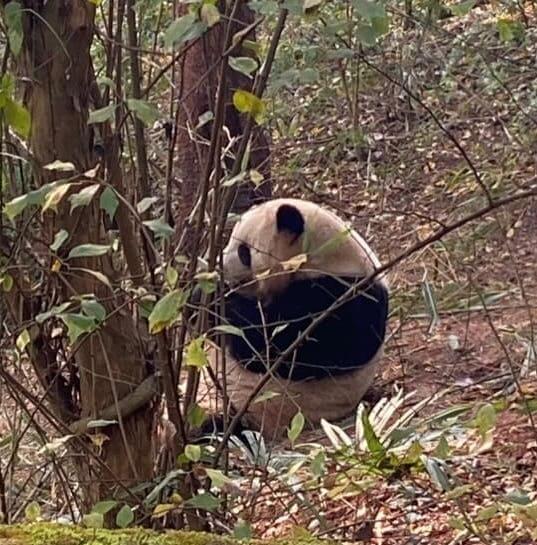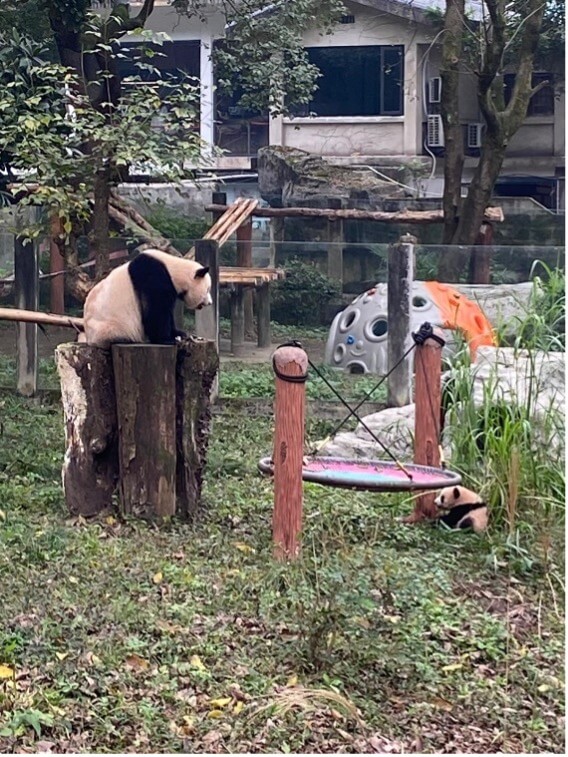Everything You Need to Know About Giant Pandas || Fun Facts, Where to Find Them & Panda Diplomacy!
The giant panda (大熊猫- dà xióngmāo), known scientifically as Ailuropoda melanoleuca (literally, “black and white cat-foot”), is a captivating and unique bear species native to China.

Recognized worldwide for its distinctive black and white fur, the giant panda has become a symbol of wildlife conservation and the national treasure of China.
Amidst its diplomatic charm (the so-called “panda diplomacy“), these brilliant bears have played a significant role in fostering international relations.
Find out all about them in this article!
Giant Pandas || Unique Features
Giant Pandas || Habitat and Distribution
Giant Pandas || Diet and Bamboo Dependency
Giant Pandas || Behaviour
Giant Pandas || Conservation Status and Threats
Giant Pandas || China’s “Panda Diplomacy”
Giant Pandas || Where to find them in China
Giant Pandas || FAQs
Giant Pandas || Unique Features
Giant pandas are instantly recognizable by their striking black-and-white fur, with patches around their eyes, ears, shoulders, and legs.
Their distinctive coloration serves as effective camouflage in their natural habitat, helping them blend into the snowy and rocky surroundings.
Giant pandas grow to between 1.2m and 1.5m, and weigh between 75kg and 135kg.
The panda’s thick, wooly coat is an adaptation to keep warm in the cool mountain climate.
Fact #1: A newborn panda is about the size of a stick of butter (about 1/900th the size of its mother!)
Want to learn how to say more than 170 animals in Chinese? Check out our ultimate guide to animals names in Chinese here!
Giant Pandas || Habitat and Distribution

Giant pandas are found in the mountain ranges of central China, primarily in Sichuan province, and to a lesser extent in neighboring Shaanxi and Gansu provinces.
Their habitat is characterized by steep slopes, cool temperatures, and an abundance of bamboo.
Historically, the giant panda’s range was much broader, encompassing much of southern and eastern China, as well as parts of Myanmar and northern Vietnam.
However, due to human activities such as farming, forest clearing, and infrastructure development, the panda’s habitat has become more fragmented.

Chinese New Year Migration 😲 What’s The Truth?
Chinese New Year Migration. The largest periodic mass migration in Chinese history. Otherwise known as 春运 (chūnyùn), millions travel home.
Giant Pandas || Diet and Bamboo Dependency
Giant pandas are primarily herbivores, with bamboo constituting over 99% of their diet!
Fact #2: Pandas consume 12-38 kg of bamboo daily (This explains why they are so chubby, right?)

Their digestive systems, however, are more suited to a carnivorous diet, making the process of extracting nutrients from bamboo a challenging task.
To compensate, pandas have developed a “pseudo-thumb,” an extension of the wrist bone, which aids in grasping bamboo shoots and leaves.
They also have extremely strong jaws to help them chomp through the thick bamboo shoots.
Smart, isn’t it?
Fact #3: Despite their bamboo-centric diet, giant pandas have been known to consume small mammals and birds occasionally.
Giant Pandas || Behaviour
Giant pandas prefer a solitary lifestyle and are known for being territorial.
While pandas are not known for being vocal, they do communicate through various means (like huffing, honking and scent marking).

These are often used during the mating season or to signal discomfort.
Pandas are known for their laid-back appearance and spend a significant portion of their day resting and sleeping (12 hours!).
Fact #4: Unlike most other bears, pandas do not hibernate.
When winter approaches, they head lower down their mountain homes to warmer temperatures.
Family time in the panda world is adorable!
Female pandas welcome one or two cubs every two years.
These fluffy little ones stick around with their moms for 18 months before they begin their independent adventures.
Finally, panda cubs love to play! Just like kids having fun, panda cubs roll around, wrestle, and engage in playful activities.
This playtime isn’t just for fun—it helps them practice and improve their physical and social skills.
Panda Trivia || Giant pandas have a remarkable sense of smell, which they use to avoid each other and maintain their solitary lifestyle. They can detect scents from other pandas, allowing them to steer clear of one another, except during the short breeding season.
Giant Pandas || Conservation Status and Threats
The giant panda, once labeled as ‘Endangered,’ saw a positive shift in its conservation status in 2016.
The International Union for Conservation of Nature (IUCN) reclassified it as ‘Vulnerable’ following a remarkable 17% increase in its population over a decade. Hooray!
Fact #5: As of today, there are less than 1,850 pandas in the wild.
However, habitat loss and fragmentation due to agriculture, timber extraction, and infrastructure development remain significant threats.
Conservation efforts include establishing reserves and wildlife corridors to connect isolated panda populations and working with local communities to develop sustainable practices.
Have you ever seen a panda in real life? Tell us about it in the comments section!
Giant Pandas || China’s “Panda Diplomacy”
Pandas, being a symbol of peace and friendship, are well-suited for diplomatic exchanges.
The origins of panda diplomacy can be traced back to the early 20th century when China began giving pandas as gifts to foreign countries.
Fact #5: The first recorded instance was in 1957 when China presented a pair of giant pandas to the Soviet Union.
Since then, pandas have been gifted to numerous countries, including the United States, Japan, and various European nations.
Moreover, panda diplomacy also serves conservation and educational purposes.
China often includes agreements with recipient countries to ensure the proper care, breeding, and conservation of the gifted pandas.
This collaboration promotes global awareness of the need for wildlife conservation, emphasizing the importance of protecting endangered species and their habitats.

What Is Panda Diplomacy & How Does It Work? 🐼
Can you really send a panda as a gift? Discover the meaning behind panda diplomacy and the history of sending pandas abroad to other countries from China.
Giant Pandas || Where to Find Pandas in China
Hundreds of pandas live in breeding centres and zoos, where they are always among the most popular attractions.

But if you are in China, where can you find them?
The most obvious answer is the Chengdu Research Base of Giant Panda Breeding, a non-profit research and breeding facility in Chengdu, Sichuan Province.
Established in 1987, their primary focus is the conservation of giant pandas and their habitats.
To create a more natural environment, the Chengdu Panda Base features large enclosures with bamboo forests, rocks, and other elements that mimic their wild habitat. However, this design makes it challenging to get up-close views of the pandas!
The Chengdu Panda Base is renowned for its successful giant panda breeding program.
Breeding pandas in captivity helps increase the population and genetic diversity of the species, contributing to overall conservation efforts. Over the years, the base has celebrated the birth of numerous panda cubs. Yay!
And besides the Chengdu Research Base of Giant Panda Breeding, where can you find more pandas?

Good news!
In Chengdu there are other three panda bases: Dujiangyan Panda Base, Woolong Panda Base, and Bifengxia Panda Base.
You can find more information about them and plan your trip accordingly in this article: Discover the Pandas in Chengdu || Where Can You Find Them?
Also, don’t forget to check out Chongqing Zoo! They’ve got over 10 of these fluffy fellas, and some are still young and full of playfulness.
The giant panda is more than just a cute and cuddly icon that holds a special place in the hearts of people worldwide.
While significant strides have been made in conserving this species, the journey is far from over.
By understanding the challenges faced by giant pandas and supporting conservation initiatives, we can contribute to ensuring a brighter future for these remarkable creatures.
Want more from this author? Check out @saratao_chinese on Instagram!
Giant Pandas || FAQs
What is a “giant panda”?
The giant panda (大熊猫 – dà xióngmāo), known scientifically as Ailuropoda melanoleuca (literally, “black and white cat-foot”), is a captivating and unique bear species native to China.
What are the unique features of pandas?
Giant pandas are instantly recognizable by their striking black-and-white fur, with patches around their eyes, ears, shoulders, and legs.
Where do pandas live?
Giant pandas are found in the mountain ranges of central China, primarily in Sichuan province, and to a lesser extent in neighboring Shaanxi and Gansu provinces.
What do pandas eat?
Giant pandas are primarily herbivores, with bamboo constituting over 99% of their diet!
What is the conservation status of pandas?
The giant panda, once labeled as ‘Endangered,’ saw a positive shift in its conservation status in 2016. The International Union for Conservation of Nature (IUCN) reclassified it as ‘Vulnerable’ following a remarkable 17% increase in its population over a decade.
What is the Chengdu Research Base of Giant Panda Breeding?
The Chengdu Research Base of Giant Panda Breeding, a non-profit research and breeding facility located in Chengdu, Sichuan Province. Established in 1987, their primary focus is the conservation of giant pandas and their habitats.
Want more from LTL?
If you wish to hear more from LTL Mandarin School why not join our mailing list.
We give plenty of handy information on learning Chinese, useful apps to learn the language and everything going on at our LTL schools!
Sign up below and become part of our ever-growing community!


 Hi, my name is Mojca. I am from Slovenia in Europe and I work as a student advisor at our Beihai school.
Hi, my name is Mojca. I am from Slovenia in Europe and I work as a student advisor at our Beihai school.




